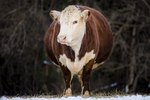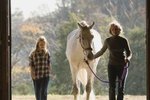
Colic is the general term for gastrointestinal ailments in grazing animals, including horses and llamas. Whether it's an equine or camelid bellyache, colic is always a veterinary emergency. Mild colics can resolve themselves with treatment, but if preliminary treatments don't improve the situation, surgery might be the only option to save your llama.
Gastrointestinal System
Your llama's stomach has three compartments. When he eats, food goes down his esophagus to the first section, where it's fermented and belched up. Your llama swallows it again, sending it into the second compartment, which absorbs nutrients. It heads into the third compartment, where more nutrients are absorbed but acids complete digestion. What remains then goes into the small intestine, consisting of the duodenum, the jejunum and the ileum. It then goes into the large intestine, through the cecum and the colon, and out the rectum as manure. Problems anywhere along this line can result in colic.
Symptoms
Suspect colic if your llama refuses to eat, rolls frequently, kicks at his side or lies flat-out down for extended periods. He could keep getting up and down. Your llama might grind his teeth in pain or behave restlessly. Your llama either stops producing manure or evacuates only small, dry feces. He might stand at the manure area, straining to defecate. If you see your animal display any of these symptoms, contact your vet immediately.
Treatment
Your vet conducts a physical examination of your llama, palpating the abdomen. She'll check his heart and respiratory rates, conduct a rectal palpation to see if there's manure present, and ask you about any recent changes in feed or management. She might insert a nasogastric tube into your llama's nose, resulting in reflux from the stomach. After taking a blood sample for testing, your vet might give your llama intravenous fluids and medications to promote gut motility. If your llama doesn't appear more comfortable or defecate within 24 hours, surgery must be considered. That must be done at a veterinary clinic, where your vet will have access to X-rays, ultrasounds and other diagnostic equipment and can make a better determination of the colic's cause before performing the operation.
Prevention
To prevent colic, make sure your llama always has plenty of fresh, clean water available and access to grass or timothy hay. He needs plenty of fiber in his diet to keep his gut moving, along with water to prevent dehydration and also move his stomach contents along. According to the Michigan State University Veterinary Teaching Hospital, the average llama eats about 45 pounds of hay per week. Avoid alfalfa, as it's too high in protein and calcium. Most llamas don't need grain, which can cause colic if overfed. Since stress can bring on colic, some basic husbandry measures can avoid it. Llamas are herd animals, so keeping a llama by himself is inherently stressful. Get your llama a companion, either another llama or an alpaca.
References
- Michigan State University Veterinary Teaching Hospital: Feeding and Caring for the Backyard Llama
- Merck Veterinary Manual: Gastrointestinal Diseases
- Rocky Mountain Llama and Alpaca Association: Stomach Ulcers
- Shag Bark Ridge Llamas: Health Care and Management for Llamas and Alpacas
- Mobile Vet: Llama Medical Information
Photo Credits
-
Hemera Technologies/Photos.com/Getty Images
Writer Bio
Jane Meggitt has been a writer for more than 20 years. In addition to reporting for a major newspaper chain, she has been published in "Horse News," "Suburban Classic," "Hoof Beats," "Equine Journal" and other publications. She has a Bachelor of Arts in English from New York University and an Associate of Arts from the American Academy of Dramatics Arts, New York City.




